
9 minute read
Snowmelt is swelling Colorado’s
Rivers
BY SHANNON MULLANE THE COLORADO SUN
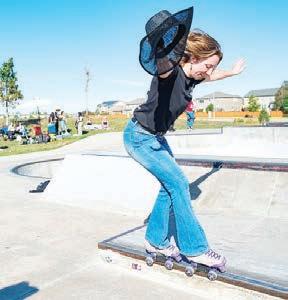
Floods, swollen rivers, road closures — Colorado’s spring runo season is in full swing and much of the snow in the state’s mountains hasn’t melted yet.
Colorado saw higher-than-average snowfall build up on the Western Slope this year, a boon for irrigators and other water users who rely on the Colorado River Basin which spans Colorado, tribal lands, six Western states and parts of Mexico. But the snowmelt, with the help of recent weather, is leading to high runo and its adverse impacts are popping up around the state like a game of whack-a-mole.
Beyond monitoring for mudslides and rockfalls loosened by rain and high runo , the Colorado Department of Transportation is also watching bridges and roads for possible closures.
“I’m seeing higher ows in almost every single drainage that we have over here (in western Colorado) than what we’ve seen probably in at least four or ve years, if not longer,” said Julie Constan, a CDOT regional director. “We had such a heavy snowpack across the entire western portion of the state, so that’s causing all of the creeks to de nitely be running higher than what we’re used to seeing.”

On the Front Range and Eastern Plains, 10 days of rain in May helped with the state’s continuing recovery from drought over the past year. e amount of the state experiencing drought conditions has dropped from 93% a year ago to just 11% today.
But the rain has also combined with snowmelt to cause ooding around Colorado. In northeastern and southwestern Colorado, communities in the White-Yampa River Basin and along the Dolores River have built sandbag barriers to slow encroaching ooding. On May 11 in Denver, Cherry Creek leapt to its highest ow rate since 1980 after intense rain supplemented by reservoir releases, according to media reports.
For anyone traveling, camping or oating the river over Memorial Day weekend, checking road and weather conditions will be key for a safe outing.
Statewide, 42 people died in waterrelated accidents in 2022, according to the Colorado Parks and Wildlife. As of May 18, two people died in con rmed water-related incidents this year. e state recommends that boaters wear life jackets regardless of age or experience level.
Campsites could also be temporarily closed. Dinosaur National Monument closed its Pot Creek campsites this month due to the possible failure of an old, earthen dam on private land. e dam is structurally sound, but the area has received so much snow this year that, as of mid-May, runo in ows increased the reservoir’s elevation to within a few inches of the dam’s crest, Park Ranger Dan Johnson said.
“ e state o ce was concerned that, should that dam fail in the middle of the night when people are camping there, it could create a hazardous situation,” Johnson said, adding that the campsites could reopen in time for Memorial Day weekend campers. e high spring runo is also impacting road conditions across the state. In southeastern Colorado, the Arkansas River ooded U.S. 50 near La Junta.
A debris ow at the Hanging Lake exit on Interstate 70 in Glenwood Canyon blocked access to the trailhead for two weeks before it reopened last week. e Forest Service announced the trail is closed again until at least June 2 because of heavy runo on the trail.
“ e amount of water coming down the trail in many spots is really impressive,” Leanne Veldhuis, EagleHoly Cross district ranger, said in a news release. “ ere is currently no good way around the water, so we have closed the trail until the runo lessens or our trail crew can mitigate it.”
CDOT is also working to repair a gaping sinkhole that appeared on Colorado 133 near Paonia. Rushing spring runo overwhelmed a culvert under the highway and caused enough erosion to collapse a section of the road that is roughly 20 to 30 feet wide — and certainly large enough to t a sedan, she said. A temporary bridge should be installed by early- to mid-June, and permanent repairs should begin this fall.
In the Upper Colorado River Basin, which includes Colorado, New Mexico, Utah and Wyoming, the amount of water peaked in early April at about 150% to 170% of the historical norm. ese states are situated upstream of Lake Powell on the UtahArizona border, one of the basin’s largest water storage reservoirs. e reservoir’s dam, Glen Canyon Dam, sends water down to Lower Basin states — Arizona, California and Nevada — which also had an exceptionally wet year, said Cody Moser, senior hydrologist at the forecast center. However in the Upper Basin above Lake Powell, most of the snowpack is still sitting at 150% to 170% of the norm, Moser said, according to SNOTEL data.
“Across the northern part of the Upper Colorado River Basin, there’s been alternating periods of sunny, warm weather that generates the snow melt and the higher ows,” he said. “And then we’ve seen those periods alternating with cooler, cloudier weather that’s brought some additional moisture in both rain and snow. It’s helped the snowmelt rate decrease, so it’s been kind of up and down in April and May.”
Southwestern Colorado has seen more continuous warm, sunny weather and thus more snowmelt than other parts of Colorado, like the northwestern region, he said.
Colorado also received higherthan-normal snowpack across elevations lower than 9,500 feet, where snow typically melts more quickly. at thick layer is also frequently downstream of reservoirs which means, depending on the location, the water is going straight into streams and rivers. at has led to an extended period of high ows, especially in the WhiteYampa River Basin in northwestern Colorado and the Dolores River Basin, Moser said. And when rain falls onto snow, as it has in isolated patches across the state, the liquid water speeds up melting even further.
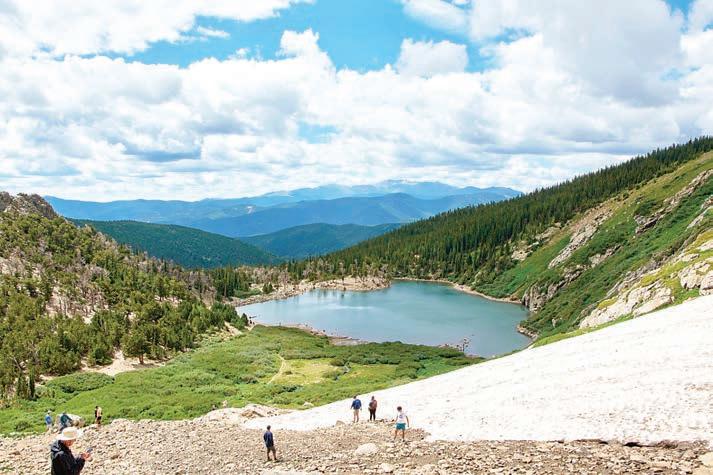
“We’ve entered into a period of showers and thunderstorms in the afternoons and evenings,” he said. “We’ve had some enhanced melt due to rain-on-snow with some of these storms.”
Colorado Housing and Finance Authority’s (CHFA’s) mission is to strengthen Colorado by investing in affordable housing and community development. We believe everyone in Colorado should have the opportunity for housing stability and economic prosperity.
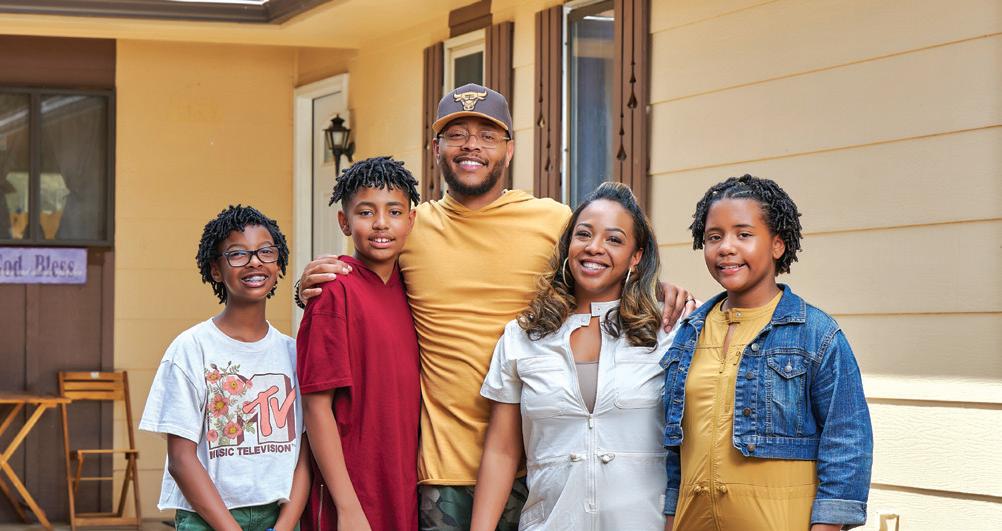
We appreciate the opportunity to get to know you.
Celize with her family, CHFA homeownership customer, Colorado Springs
“Lots of monitoring going on, but so far, the only real major failure we’ve had has been on 133,” Constan said. “It’s a good thing that there’s only been one major failure and everything else pulled together OK.” is winter, Colorado saw storm after storm add snow to the growing snowpack in the mountains. e amount of liquid water in the snow, called the snow-water equivalent, across the Western Slope was 130% to 140% of the median between 1991 and 2020, according to the Colorado Basin River Forecast Center. e estimate is based on SNOTEL data collected using a network of highelevation instruments that measure snowpack. On the Front Range, the snow-water equivalent lagged below its median this winter. e Colorado Sun co-owns Colorado Community Media as a partner in the Colorado News Conservancy. It is a reader-supported news organization dedicated to covering the people, places and policies that matter in Colorado. Read more, sign up for free newsletters and subscribe at coloradosun.com. based after school lm production company, Tomorrow Maker Studios.
By early April, that buildup peaked.
SNOTEL sites are generally located above 9,000 feet so lower elevation runo isn’t re ected in basinwide snow-water equivalent percentages. ese sites target between 9,000 and 11,500 feet where most of the snowpack typically accumulates. at’s why the snow-water equivalent percentages from SNOTEL data have not changed by much, he said.
“ ere’s still a lot of high-elevation snow up there,” Moser said.



“Celebrating Indigenous art is very important to me and my work because it’s a way to reclaim and honor something that was lost and taken from me,” Garibay said. “I grew up in a very culturally rich environment, but for the most part, most of the aspects of that culture are things that are a result of Spanish colonization.”
Spanish isn’t the language his ancestors spoke, and Catholicism isn’t the religion they practiced, Garibay said.
“ e architecture people typically associate with Mexico is that of European design, likely constructed out of my ancestors’ demolished buildings,” Garibay said. “Celebrating Indigenous art is one of the few ways that I have left to reclaim this missing piece of my culture.” is June, the McNichols Civic Center Building will be host to an elaborate ofrenda created by Garibay and his creative partner, Adrianna Baez. “We are using EVA foam, cardboard, real moss, plastic owers, several di erent lights, paint, a few di erent textiles and PVC piping to construct our ofrenda,” said Baez. “ e design work took about a week, and we are hoping to construct it in about two weeks. We have already begun constructing some of the components so that assembly will be easier, and we will have a larger crew to help with construction at the McNichols Civic Center Building.” e ofrenda will be on display June 9-15 and honor the lives of artists and creators who were lost during the COVID-19 pandemic. Garibay and Baez’s ofrenda is in uenced by Mayan architecture and is topped with a skull inspired by Cizin, the Mayan god of death and earthquakes. In conjunction with Garibay and Baez’s ofrenda, the public is invited to bring photos of people they have recently lost and place them on a community altar. e ofrenda is a part of Denver’s Indigenous comic and art festival called áyA Con, which takes place June 9-11. It is a celebration of indigene- ity, hosted by and highlighting North American Indigenous creators. is all-inclusive familyfriendly festival features comic creators, bead artists, musicians, digital illustrators, drag ashion performance, designers, Indigenous dancers and more. áyA Con is a collaborative festival with events taking place at several locations in Denver. e ofrenda, art and select performances will take place at the McNichols Civic Center Building. Panels, art making and community booths with interactive activities will take place at the Denver Art Museum. e Levitt Pavilion will also be hosting Rez Metal night, a free concert with a lineup of ve Indigenous heavy metal bands.
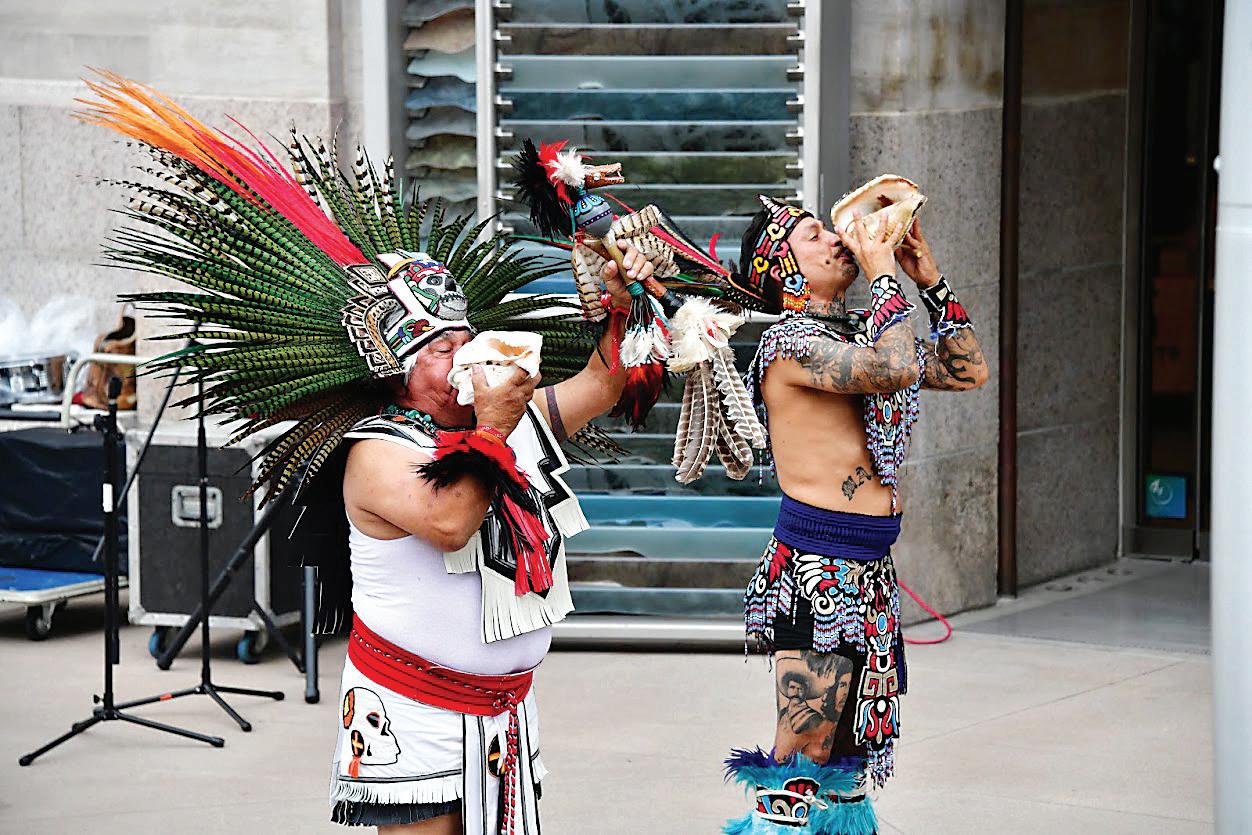
“Come to áyA Con to build connections, celebrate the di erences in all cultures and bond over fandoms,” said Kristina Maldonado Bad Hand, one of the organizers for the áyA Con event. “ ere is something for everyone. Our show is very eclectic. We have a wide range of artistic practices, music and stories, all centered around Garibay and Baez’s áyA Con Ofrenda is also something not-to-miss, Garibay said, adding it’s important to honor the lives of artists and creators because of their artistic struggle.
“ is is something that all true artists can relate to. It’s what connects us. ey will never have a chance to nish the projects they were in the process of bringing to life,” said Garibay. “My hope is that when people see the altar, they will discover some of these amazing artists and look into their body of work. is will allow the artists and their work to continue inspiring the living and lling their lives with beauty.”
To learn more about the áyA Con Ofrenda at the McNichols Civic Center Building, visit mcnicholsbuilding. com/exhibitions. For more information and a full schedule of áyA Con events, visit ayacondenver.art.
Adrian Juarez RESPECT ACADEMY
Future plans: Pursue a Bachelor of Science in Business Administration from the University of Colorado-Denver.
Quote: “Academically, I’ve learned a lot. But I’ve also learned that mistakes and errors are a part of growth. I learned that giving up is never the answer. We owe it to ourselves and those who support us to try, even if we fail because failure creates a bigger success. e key is to just keep trying.”
Steven David Esquivel
DSST:
Cole High School
Future plans: Major in biomedical and mechanical engineering at Colorado State University.
Quote: “People aren’t always going to be by your side, and there are others that will. So at the end of the day, do what you want to do for yourself and not for others.”
DSST: BYERS
Future plans: Attend Tarleton State University in Texas for Division 1 Cheer, major in nursing.
Quote: “ e class of 2023 is special because of how close we have grown as a class, especially because our high school experience has had so many unexpected situations.”
Quincy Breaux
Bradford Murphy
DSST: BYERS
Future plans: Study Economics at Texas A&M.
Quote: “ e class of 2023 is special because we have developed a voice for ourselves to stand up and advocate for ourselves, and for what we hope to change for the future.”
Janet Santos-Castaneda
Hawa Welongo
Denver South High School
Future plans: Study integrated nursing at the Community College of Denver.
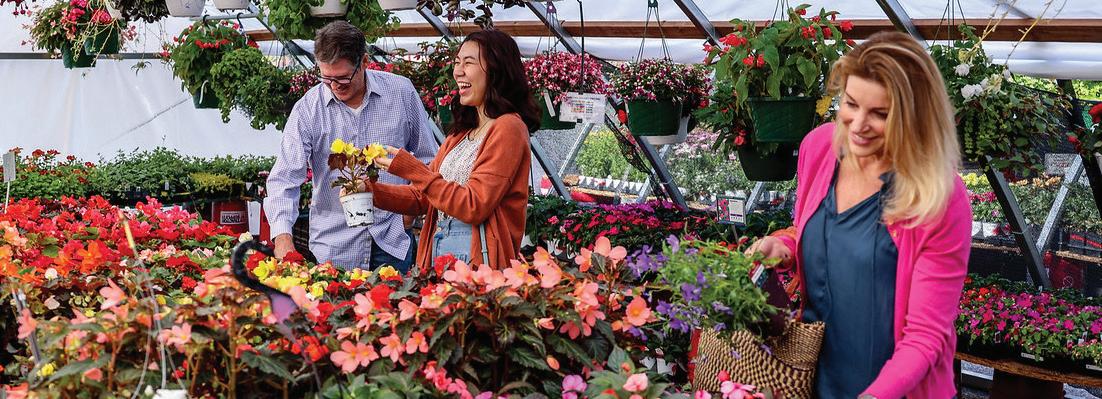
Quote: “English is not my rst language, so high school taught me to ask for support and join the community to learn the language and grow as a student.”
DSST:
Conservatory Green High School
Future plans: Attend the Colorado School of Mines in Golden.
Quote: “Our Class of 2023, we are the breaking point of diversity and education. When I was going out and visiting college campuses, I noticed how White the campuses were. Now with our class, so many of us are heading to college and we are making the di erence and change in higher education.”
DSST: COLE HIGH SCHOOL
Future plans: Major in education at Regis University.
Quote: “ e Class of 2023 is really good on advocating for themselves, not afraid to speak their minds, and one day in the future, they will be seen as role models. If no one believes in you, you need to believe in yourself because at the end of day, you are yourself.”
DSST:
Conservatory Green High School
Future plans: Attend Colorado College.
Quote: “Besides the hard skills, like the strong academics, I have learned a lot about team work, the soft skills of working with others. I know that these are the skills that will be valuable for both college and lifelong success.”








